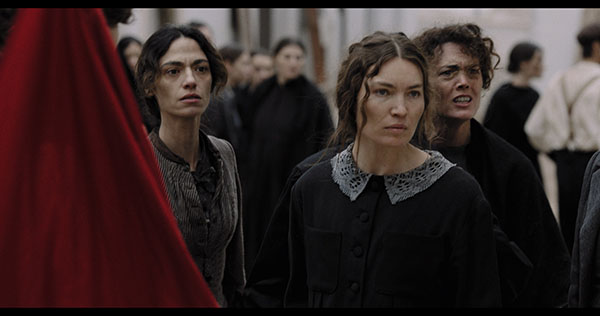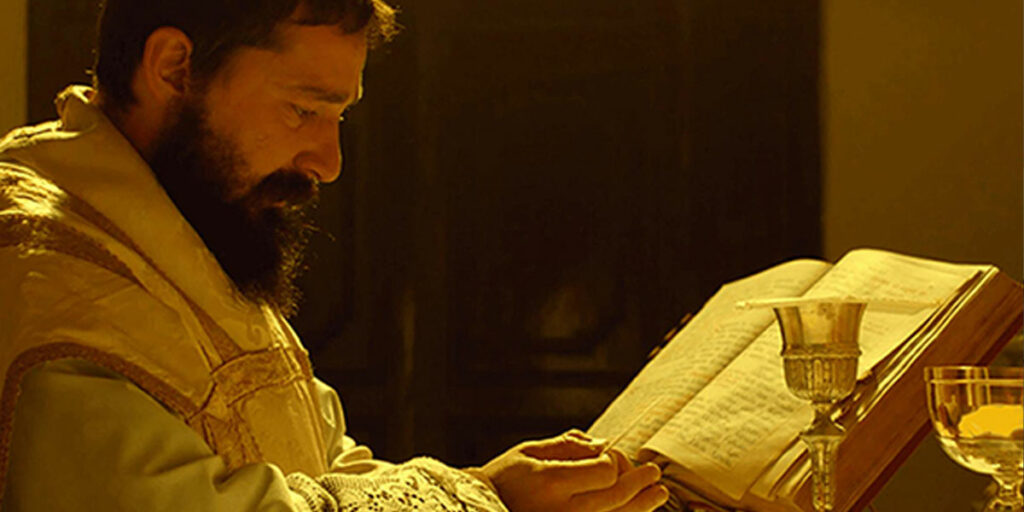Abel Ferrara’s Padre Pio compensates for its underwhelming character study with politically charged storylines.
Anyone expecting Padre Pio to be a movie about the miraculous saint with divine stigmas, said to be able to stop warplanes with a wave of hands, will be deeply disappointed. This is more a film about faith than religion. It’s more about nameless peasants forgotten in time than the timeless figure of Padre Pio, a revered Catholic saint known for possessing marks corresponding to those left on Jesus Christ’s body for most of his life and his mystic experiences. It’s a movie about war. Above else, it’s weird and fussy, just like all Ferrara movies are. A young Padre Pio (Shia LaBeouf, of A Man Named Scott) arrives at a remote Capuchin monastery where he’ll be forced to cope with his troubled mind and his deepest desires. In parallel to that, a band of soldiers return from the horrors of World War I to the poor town of San Giovanni Rotondo, Italy, where a small-scale massacre took place in 1920. In the film, the massacre represents a death omen for the rest of the bloody 20th century.
After all, Padre Pio is much more than an unconventional biopic. It’s also Shia LaBeouf’s miracle, for better or for worse. Without getting into the actor’s tumultuous scandals and accusations, accepting the role of a catholic saint is an eye-rolling obvious indication of change he attempts to pass on. But the feat goes further than that: after visiting Padre Pio’s house and sleeping in his bed, LaBeouf has converted to Catholicism and, during the process of playing the character, has supposedly found the faith and guidance he needed to go through his “darkest times”. A great marketing approach indeed, relevant both to the fans who wish to see the actor’s redemption and to the ones who take his words as just another card pulled to save his reputation.
The result is quite underwhelming, though: it often feels as if LaBeouf isn’t playing Padre Pio at all, but rather himself. The actor’s refusal to adhere to an Italian accent as suggested by the director is the first of many indications of LaBeouf’s self-indulgence; there’s a controversial scene in which Padre Pio, one of the most popular saints of the Catholic faith, shouts “shut the f##k up”, which once again feels much more like LaBeouf himself than the character he’s playing. And the biggest surprise of all, in the end, is how Padre Pio feels much more like a supporting character in his story than an actual key figure in the community.

Thankfully, Padre Pio is also Ferrara’s anti-fascist prayer, and there couldn’t be a better time for this movie to come out than now, as war and several violent conflicts stretch in the East and Italy itself is threatened by fascist alliances once again. Ferrara couldn’t have been more obvious in his statement. A good chunk of the film, if not the majority of it, follows the lives of the peasants of San Giovanni Rotondo as they fight their own little battles caused by a common evil: the War.
The cinematography (Alessandro Abate) conveys an atmosphere of sorrow and despair similar to the movies of Béla Tarr, and there’s thorough attention to how the lighting should pass on important visual messages. Everything is always too bright or too dark, with shadows offering narrative tools that call back to German Expressionism. Through dimly lit rooms and alleys, Ferrara uses the absence of light as a presage of fear and terror, elements that he explores with nightmarish imagery and a nauseating shaky camera. This is how Padre Pio effectively plays with the audience as well; when a scene gets darker, it gradually escalates into something strange, sinister even.
It’s difficult not to compare Padre Pio with Ferrara’s previous works. The director has an extensive list of exploitative movies, such as Bad Lieutenant and Ms. 45, that explore the extremes of human depravity in a story packed with drugs, sex, and graphic violence. In some ways, Padre Pio might be one of Ferrara’s most accessible works to this day; it’s clear from the get-go where the narrative is heading, and each character’s motivation is well established in the black-and-white world of Ferrara’s San Giovanni Rotondo.
It’s black and white because the characters are either good or bad, period. You got the peasants trying to stand their ground and fight for what they think is right versus corrupted men who only care about their own interests. It’s the collective mind against fascism’s oppressive navel-gazing. Heaven and hell on Earth, coexisting. This approach only works so well because the only character who shies away from this black-and-white perspective is Padre Pio himself: a tormented priest, haunted by demons but with a reliable faith. If we’re all sinners, Padre Pio’s role is to mediate good and bad miracles.
Padre Pio was screened at the Festival do Rio on October 12, 2022 and will be released in US theaters on June 2, 2023.

